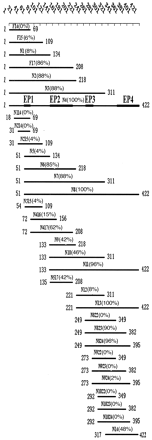Antigenicity analysis of different regions of the severe acute respiratory syndrome coronavirus nucleocapsid protein
- PMID: 15054081
- PMCID: PMC7108132
- DOI: 10.1373/clinchem.2004.031096
Antigenicity analysis of different regions of the severe acute respiratory syndrome coronavirus nucleocapsid protein
Abstract
Background: The widespread threat of severe acute respiratory syndrome (SARS) to human health has made urgent the development of fast and accurate analytical methods for its early diagnosis and a safe and efficient antiviral vaccine for preventive use. For this purpose, we investigated the antigenicity of different regions of the SARS coronavirus (SARS-CoV) nucleocapsid (N) protein.
Methods: The cDNA for full-length N protein and its various regions from the SARS-CoV was cloned and expressed in Escherichia coli. After purification, all of the protein fragments were printed on glass slides to fabricate a protein microarray and then probed with the sera from SARS patients to determine the reactivity of these protein fragments.
Results: The full-length protein and two other fragments reacted with all 52 sera tested. Four important regions with possible epitopes were identified and named as EP1 (amino acids 51-71), EP2 (134-208), EP3 (249-273), and EP4 (349-422), respectively. EP2 and EP4 possessed linear epitopes, whereas EP1 and EP2 were able to form conformational epitopes that could react with most (>80%) of the tested sera. EP3 and EP4 also formed conformational epitopes, and antibodies against these epitopes existed in all 52 of the sera tested.
Conclusion: The N protein is a highly immunogenic protein of the SARS-CoV. Conformational epitopes are important for this protein, and antigenicity of the COOH terminus is higher than that of the NH(2) terminus. The N protein is a potential diagnostic antigen and vaccine candidate for SARS-CoV.
Figures



References
-
- Drosten C, Gunther S, Preiser W, van der Werf S, Brodt HR, Becker S, et al. Identification of a novel coronavirus in patients with severe acute respiratory syndrome. N Engl J Med 2003;348:1967-1976. - PubMed
-
- Ksiazek TG, Erdman D, Goldsmith CS, Zaki SR, Peret T, Emery S, et al. A novel coronavirus associated with severe acute respiratory syndrome. N Engl J Med 2003;348:1953-1966. - PubMed
-
- Marra MA, Jones SJ, Astell CR, Holt RA, Brooks-Wilson A, Butterfield YS, et al. The genome sequence of the SARS-associated coronavirus. Science 2003;300:1399-1404. - PubMed
-
- Rota PA, Oberste MS, Monroe SS, Nix WA, Campagnoli R, Icenogle JP, et al. Characterization of a novel coronavirus associated with severe acute respiratory syndrome. Science 2003;300:1394-1399. - PubMed
Publication types
MeSH terms
Substances
LinkOut - more resources
Full Text Sources
Other Literature Sources
Miscellaneous

